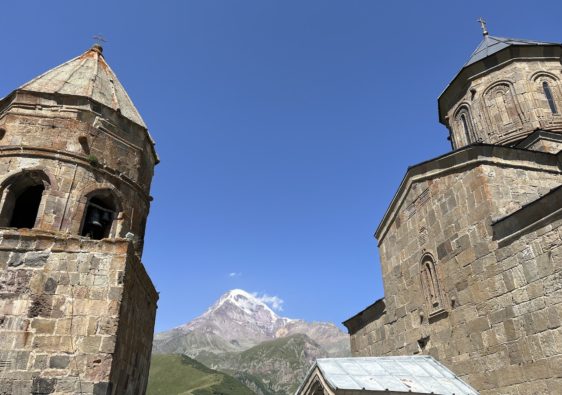Georgia is a wine region. Georgians proudly proclaim that they are the originator of wine – whether that is true or not, they certainly take a lot of pride in their wine, and it still made in the traditional way in clay jugs called qvevri.
If you see the statue of the Mother of Georgia you’ll understand the place that wine has in the heart of Georgians. The statue has a sword in one hand and a cup of wine in the other, symbolizing their boundless hospitality – unless you come with hostile intentions and then you’ll get the sword.


Because we’d heard so much about Georgian wine, we knew we had to go to their primary wine region, Kakheti and do some wine tastings.
I won’t recommend the specific tour we chose as there were only 2 tastings in the 12 hour day, with the emphasis of the tour being on the whole Kakheti Region [including a visit to a monastery, traditional bread making, the town of Sighnaghi] versus being on the wine of the Region as we’d hoped.
If I were to do the tour again, I would do a private tour with our own guide, which would allow us to have more flexibility than if we’re in a group tour with 15 others.
I would make sure that the tour included:
- Tastings in at least 3 – 4 wineries
- Traditional bread making – this was a highlight! More on that below.
While I enjoyed the town of Sighnaghi, I would not choose to go to it again as part of a wine tour. It’s too far for a one-day tour and made it feel like we were in the bus for more of the day than I would have liked. I would only include Sighnaghi in a tour if it was a two-day tour or en route to someplace else.
The wine – we went to two wineries:
- The Industrial warehouse. Our small tour of ~15 joined with a busload [or two] of people and headed into the wine warehouse, where massive tanks of wine waited to be bottled and distributed. We sampled wine directly from a spigot in the side of the tank. Despite not being the relaxing tasting in a beautiful vineyard I’d envisioned, it was interesting to see the industrial workings of the winery. We were each given glasses and put the glass under the spigot in turn.
- The family vineyard. We stopped at another vineyard and it was [almost] the experience we’d been looking for. It was run by a family of winemakers and they took pride in their country and their wine. There were about 15 of us in the tasting at once, and we lined up in a semi-circle with our glasses in hand. The son of the owner poured about 10 tastings starting from the light whites which were supposedly light enough to “drink all day” to the heavier reds. Saperavi is the primary grape of the region but its flavor can vary from semi-sweet to dry depending on growing conditions and how it’s produced.
The vineyard also hosted dinner for us, in typical Georgian family-style dining with lots of small dishes to share around the table.
Traditional bread-making – Puri. We didn’t know what to expect when the bus pulled up beside a small building – but we were all shuttled inside, where there was a wood-burning oven that was shaped like a well about 3 feet deep. There was a table with small mounds of dough ready to be shaped and baked into Puri – the traditional Georgian bread. One at a time we were asked to shape our dough into elongated crescent-moon shapes. I pulled out my hand sanitizer before touching the dough [as there were no visible washing facilities] and was immediately chided – the oven is blazing hot and would kill whatever germs I had on my hands. Fair. So, after shaping the dough, I was asked to stick my head in the well and slap the dough onto the side of the oven. Having visions of Hansel and Gretel, I leaned over and got a faceful of heat, slapped the dough on as quickly as I could and got my head back out. The woman who was clearly the owner and expert baker patiently leaned over, in no rush, and fixed my sloppy slap job and properly affixed the dough to the oven. The rest of the tour lined up to do the same inexpert shaping and rough slap into the oven, the woman patiently fixing our efforts each time. When each one was done, she pulled them out of the oven with what looked like a fireplace poker, and dropped each one onto a page of a newspaper and handed it to whoever “made” that puri.
The result – puri tasted like the best pizza crust you’ve ever had. Hot, crispy on the outside and chewy inside.





